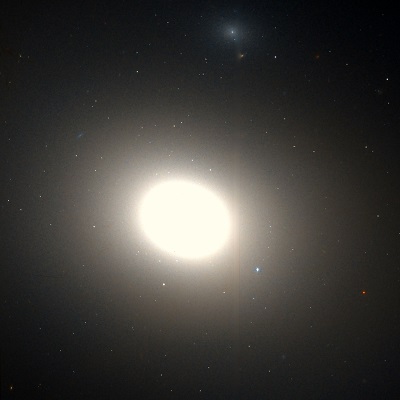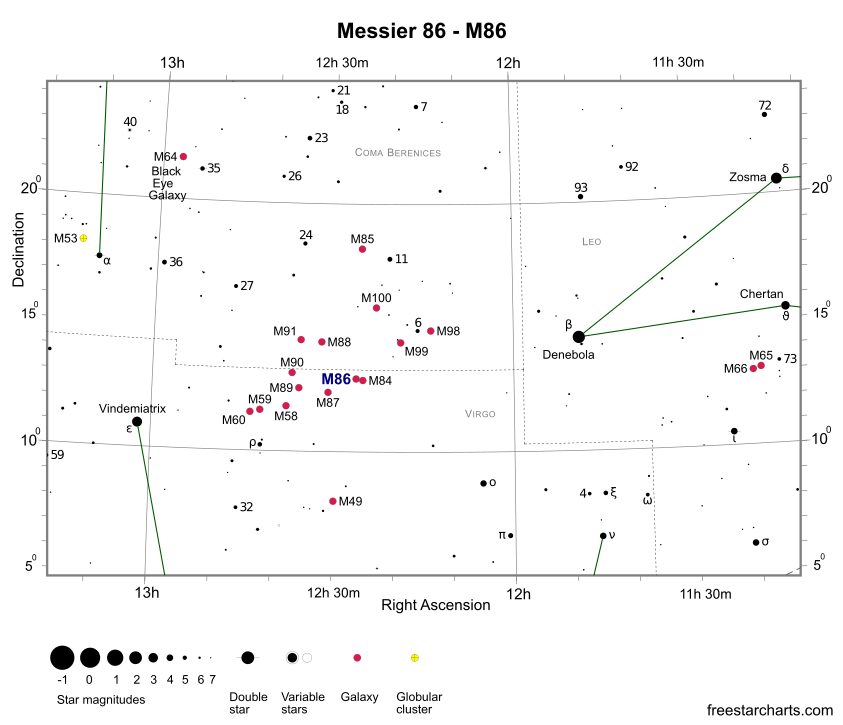M86 is a giant lenticular or elliptical galaxy located in Virgo. This galaxy shines at magnitude +9.3 and is therefore one of the brightest cluster members. It lies at the heart of the group and forms a conspicuous pair with close neighbour and almost identical twin, M84. Through a medium size scope, M86 appears as a bright elongated patch of light. Also visible in the same low/medium power eyepiece field of view is M84.
The galaxy was discovered by Charles Messier on March 18, 1781. This night was extremely productive for Messier. In addition, he discovered another seven Virgo cluster members and re-discovered globular cluster M92 in Hercules.
It's currently uncertain what type of galaxy M86 is. It could be a type S0 lenticular or an elliptical galaxy of type E3. The galaxy is unusual since it's blue shifted and therefore moving towards the Milky Way. Due to the expansion of the Universe, most galaxies are receding and exhibit redshifts. However, M86 is falling towards the centre of the Virgo cluster and as a result is currently moving towards us at a speed of 244 km/s. The resulting blueshift is the highest of all Messier objects.
M86 is positioned close to the Virgo-Coma Berenices constellation border and can be found by imagining a line connecting Denebola (β Leo - mag. +2.1) with Vindemiatrix (ε Vir - mag. +2.8). Towards the centre of this line is M86, with M84 positioned 17 arc minutes further west.
The Virgo cluster galaxies are best seen during the months of March, April and May.


Finder Chart for M86 - pdf format (credit:- freestarcharts)
M86 is a challenging binocular object. It can be spotted with 7x50 or 10x50 models but requires dark skies and good seeing conditions. Together with M84, both galaxies appear as faint smudges of light in the same field of view. An 80mm (3.1-inch) scope reveals two small oval shapes with brighter centres. M86 is slightly bigger than M84. Due to their low surface brightness, larger telescopes show the surrounding halos better. With 200mm (8-inch) reflectors it's possible to spot several more faint galaxies in the same field of view. These include NGC 4435, NGC 4388, NGC 4402 and NGC 4438. The giant elliptical galaxy M87 is located about 1.5 degrees southeast of the M84/M86 pair.
M86 has an apparent diameter of 8.9 x 5.8 arc minutes. At a distance of 52 million light-years this corresponds to a spatial diameter of 135,000 light-years. The galaxy is estimated to contain at least 400 billion stars. In addition, an extensive system of globular clusters that totals around 3,800.
M86 Data Table
| Messier | 86 |
|---|---|
| NGC | 4406 |
| Object Type | Lenticular galaxy or (Elliptical galaxy) |
| Classification | S0 (or E3) |
| Constellation | Virgo |
| Distance (light-years) | 52 Million |
| Apparent Mag. | +9.3 |
| RA (J2000) | 12h 26m 12s |
| DEC (J2000) | +12d 56m 47s |
| Apparent Size (arc mins) | 8.9 x 5.8 |
| Radius (light-years) | 67,500 |
| Number of Stars | >400 Billion |
| Notable Feature | Displays the highest blue shift of all Messier objects |